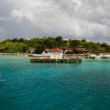Statistics, Geography and Development in the Caribbean Region
By George Nicholson and Nayaatha Taitt
Op-Ed Contributors
Lifting persons in developing countries out of poverty and improving the stance of the country itself has long been a challenge faced by governments, with the Greater Caribbean being no exception.
While there have been some successes, particularly in poverty alleviation, by and large, wholesale movement of country metrics have eluded most governments. Following the formulation of the Millennium Development Goals (MDGs), we have experienced an increase in focus on measuring outcomes and results to guide policy development and poverty reduction. Today we examine the role of geography and the use of statistics in the thrust towards development outcomes.
We are living in a global information society where the amount of information and its flow to society is increasing. Many are now recognizing that statistics plays a major role in shaping and providing scientific information that is useful in almost every aspect of human life. Modern decision making, whether done by a national government or an international agency, is increasingly using statistical methods to improve the quality of information.
Such an increasing appreciation of the role, power and importance of statistics is now leading to a higher priority being attached to statistical capacity development in many developing countries.
The established United Nations “High Level Panel on the Post-2015 Development Agenda” in its report entitled “A New Global Partnership: Eradicate Poverty and Transform Economies through Sustainable Development,” sets out “inter alia” a universal agenda to eradicate extreme poverty from the face of the earth by 2030, and deliver on the promise of sustainable development. The report called for a data revolution for sustainable development with a new international initiative to improve the quality of statistics and information available to citizens.
Despite this international consensus on the importance of reliable national statistics, many developing countries do not have the sound and credible national statistical systems needed to underpin the development processes. Inadequate statistics has always been a major limitation to studies done on Caribbean economies. The Caribbean region has often been described as data poor with many differing perspectives to correcting this problem. In May 2012, the United Nations Economic Commission for Latin America and the Caribbean (UNECLAC) highlighted the fact that Caribbean countries continue to struggle with enhancing their statistical capacities. In the area of economic statistics notable progress has been made but significant gaps exist in all other areas of statistics. Improved statistics by itself however will not solve the myriad problems that the region faces.
Understanding that location and place is a vital component of effective decision making, geoinformatics, also known as Geographic Information Science (GIS), is becoming a rapidly expanding field. It involves the use of techniques for proper storage, classification, representation and analysis of data so that it can be used to efficiently.
In the area of risk reduction, linking GIS to hazard mapping involves the layering of a complex number of datasets on environment, land ownership, land use and transport in order to accurately capture vulnerability. As a primary input, such data includes the names, locations and sizes of population centres retrieved from national census data. Second, information on physical infrastructure such as roads, residential housing and commercial buildings gathered from state agencies responsible for issuing building permits and maintaining infrastructure must also be included and assessed. These databases must be dynamically linked and updated in near real-time as vulnerability and hazard profiles frequently change.
Macroeconomic vulnerability to natural hazards is predicated however on five basic conditions that can be classified both as location and time specific. These include: the type of natural hazard, the overall structure of the economy, the geographic size of a country, the country’s income level and stage of development, and the prevailing socioeconomic conditions, including the policy environment and the state of the economy. Taking into account the above criteria, vulnerability therefore is not merely a function of hazard events and the physical space and but rather its intersection with other social and economic variables.
Aside from locating and mapping physical vulnerability, geospatial data must then be added to other socioeconomic and demographic data so as to facilitate informed decision-making among policy makers. In plotting socioeconomic variables, a national land-use data layer serves as the primary input in this instance. An INGC study on Spatial Data Infrastructures notes that “Hazard zones can be subdivided by economic activities such as agriculture, forestry, mining, recreational, transportation, industrial, commercial, and residential.” In addition, other economic indices such as per capita income, unemployment rate, per capita motor vehicle ownership, and proportion of residents that have personal prop¬erty and commercial insurance are all important indicators of the ability of the population to recover after the event. This type of data is usually recorded in census tabulations or annual tax returns and could also be incorporated into the platform.
In examining those communities often considered ‘vulnerable’, analysis of the above statistical indices would reveal that it is specific social conditions that expose some social groups to the potential for greater harm when a disaster strikes, thereby limiting their ability to cope. Regionally, despite increasing urbanisation, a large share of the Caribbean’s population live in what can be considered rural areas, out of reach of the policies designed to reduce poverty, and removed from employment opportunities. Little regulation has caused the acquisition of housing characterised by non-existent public infrastructure, unsafe dwellings and overcrowding. It then results that disaster risk is disproportionally concentred in lower-income households and among traditionally marginalised groups such as women, children and the disabled. It is this problem, as persons seek better fortunes, which drives urbanisation leading to increase vulnerability. These same persons then become further entrenched in their powerlessness and exclusion, reinforcing poverty and undermining development.
It is clear therefore that vulnerability is in part socially produced. With economic development strategy being sensitive to the poor and at risk, strategies around risk reduction should focus on reducing economic vulnerability of marginal communities. Resilience steps in here as an important component of response planning as it refers to the capacity of a country’s economy to absorb losses and recover. We therefore need a multidimensional approach to examine issues of vulnerability, cognizant of the fact that improved resilience of the community level leads to better allocation of public resources. Additionally, improving the livelihood of at risk population drives the macro and micro economic metrics in the right direction. Administrative agencies must therefore seek to create new tools that are able to critically examine, with certainty risk levels of communities so there can be targeted interventions, rather than solely facilitating political goals.
With the cooperation of Mexico who currently chairs the United National Initiative on Global Geospatial Information Management (UN-GGIM) Regional Committee for the Americas, the ACS is currently implementing the project “Caribbean Geospatial Information Infrastructure Strengthening”. This project seeks to promote the development of regional spatial data infrastructure by strengthening the generation, use and sharing of geospatial information in eleven countries in the Caribbean and integrating them into the wider UN-GGIM platform. As part of the project, these countries participated in the recently concluded Fourth Session of the United Nations Committee of Experts on Global Geospatial Information Management which took place at the United Nations Headquarters in New York. This serves as a precursor to their formal integration into the UN-GGIM Americas sub-group.
Addressing underlying risk drivers is critical to effectively managing disaster risk and ensuring future resilience and sustainability. It is in this space that the merit of use of statistics and use of informatics tools become visible as the ACS works towards the establishment of a Caribbean territorial information platform for disaster prevention. Effective planning on all fronts, taking into account economic, social and environmental data is critical in bolstering human capacity and furthering sustainable development objectives.
George Nicholson is the Director of Transport and Disaster Risk Reduction and Nayaatha Taitt is the Research Assistant of Transport and Disaster Risk Reduction of the Association of Caribbean States. Any correspondence or feedback should be sent to feedback@acs-aec.org.







